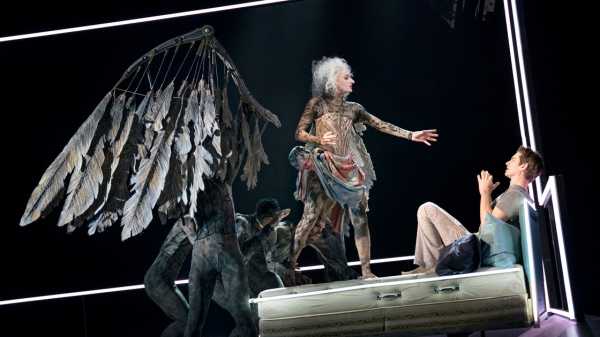
Wading through a year’s worth of ticket stubs (Playbills take up too much space), I’ve noticed a common thread. It’s the theme of terra firma not being so firma—of finding cracks in a foundation you thought was rock solid, whether the U.S. Constitution, a time-tested love story, or memory itself. Perhaps I’m projecting: this year (like the year before) was one in which the world felt like an unsafe bet, and America like a bait and switch. Or maybe playwrights and directors are responding to our disorienting era by echoing the uncertainty onstage—and by pulling the rug from under our feet.
After all, this was the year that Eliza Doolittle walked out on Henry Higgins at the end of “My Fair Lady,” instead of handing him his slippers. It was the year that Curly, the smiling hero of “Oklahoma!,” seemed like more of a sociopath than the villainous Jud Fry. In “Network,” Bryan Cranston’s Howard Beale dropped his reassuring-anchorman act and let out a primal scream. In “The Waverly Gallery,” Elaine May’s Gladys Green watched her own mind and memory slip away. In “What the Constitution Means to Me,” the writer-performer Heidi Schreck examined the fault lines in her teen-age self—and in the country’s founding document. And three playwrights of color, Jackie Sibblies Drury (“Fairview”), Young Jean Lee (“Straight White Men”), and Jeremy O. Harris (“Slave Play”), found new and provocative ways of unsettling audiences’ perceptions, turning the fourth wall into a funny mirror of their own devising.

2018 in Review
New Yorker writers reflect on the year’s best.
Before the roundup, a few caveats. First, I didn’t see everything. Some critically beloved shows came and went too fast. (Sorry, “Yerma”!) Others conflicted with a quiet evening at home. And this list is confined to New York, despite noteworthy theatre across the country and around the world. But here’s the best stuff I saw within reach of a subway ride.
10. “Harry Potter and the Cursed Child, Parts One and Two”
Forget everything I just said. John Tiffany’s mammoth staging of this time-hopping Hogwarts adventure was an exemplar of good, old-fashioned stagecraft. Its five hours zipped by, even for an audience member unversed in Potterdom. (My poor plus-one had to field questions like “Is Voldemort a person or a thing?”) The story, which takes place years after the books left off, is part “Back to the Future Part II,” part “The Man in the High Castle,” and there’s a political allegory in there, if you want to see it. Mostly, Jack Thorne’s Tony Award-winning play (based on a story by Thorne, Tiffany, and J. K. Rowling) is a terrific yarn, told with well-funded wizardry that delights and surprises the eye. Special mention goes to Anthony Boyle, who plays a punky Scorpius Malfoy.
9. “Miles for Mary”
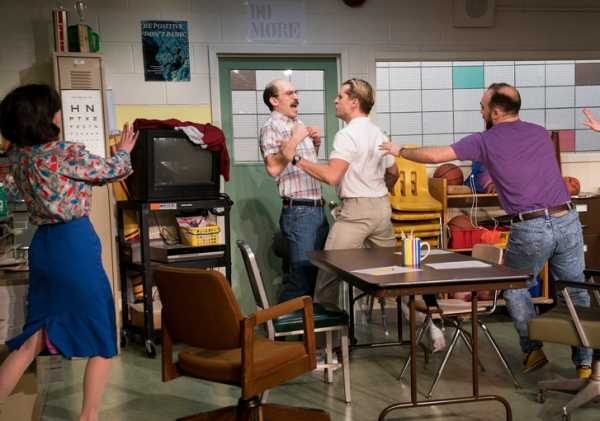
Photograph by Sara Krulwich / NYT / Redux
The collaborative troupe the Mad Ones brought this crackerjack comedy to Playwrights Horizons, after a 2017 run at the Bushwick Starr. Set in the faculty lounge of an Ohio high school in 1988, it follows a group of passive-aggressive teachers planning an annual public-access telethon, a process that naturally devolves into betrayals, recriminations, and heartbreak. Lila Neugebauer’s production got every cringeworthy detail right—from file cabinets to bangs—and revealed just how funny pettiness can be.
8. “My Fair Lady”
Lincoln Center Theatre does what it—and the director Bartlett Sher—do best: a sumptuous revival of a classic mid-century musical. Michael Yeargan’s marvellously detailed sets fill up the Vivian Beaumont, giving Eliza Doolittle (Lauren Ambrose) and Henry Higgins (Harry Hadden-Paton) a grand stage on which to spar. Everything old about the show still works, including the show-stopping “The Rain in Spain.” But new things work, too, such as an ambivalent ending that harks back to George Bernard Shaw’s original while pointing toward the gender politics of 2018. All that, plus Norbert Leo Butz and Diana Rigg, in supporting roles. The incandescent Laura Benanti plays Eliza through February 17th.
MORE FROM
2018 in Review

The Best Outfits of 2018

More Books We Loved in 2018

Trump in 2018: A Cartoon Review

The Year in Trump Freakouts

Eight Albums That Defined 2018 for Me
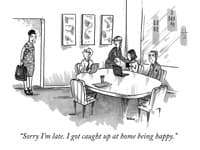
The Most Popular New Yorker Cartoons of 2018 on Instagram
7. “Network”
Howard Beale is back, and right on schedule. Ivo van Hove’s discordant version of the 1976 Sidney Lumet–Paddy Chayefsky film gives Bryan Cranston a chance to thrillingly rant and rave, as a news anchor who unravels on camera and becomes a populist hero. As Alexandra Schwartz points out in her review, not everything in the production works (especially a tacked-on ending that bangs you over the head with political relevance), but what does work is extraordinary, starting with Cranston’s barn-burning soliloquies. What exhilarated me the most was how many metatheatrical layers the piece took on, as if it had always been meant for the stage. The theatre audience is now Beale’s audience, and, when he finally bellows his famous catchphrase (“I’m mad as hell, and I’m not going to take this anymore!”), we’re ravenous for it. It’s at the Belasco through April 28th.
6. “Angels in America”
Like “Harry Potter,” Marianne Elliott’s staging of Tony Kushner’s epic fantasia was an all-day (or two-night) affair. (Weirdly, James Franco was in my audience for both. Say what you want about him, but the guy loves a theatre marathon.) Elliott brought a keen eye to Kushner’s massive, ungovernable text, which reframes the nineteen-eighties AIDS crisis as a metaphysical odyssey. Elliott’s version, which originated at the National Theatre, cast a kind of black magic, reimagining the angel as a tattered, pigeon-like nuisance. The production felt big but not ponderous, leaving plenty of air for Kushner’s droll humor. And Nathan Lane put an indelible stamp on the role of Roy Cohn, the closeted power broker and real-life mentor to Donald Trump—whose presence, though unmentioned, was felt.
5. “Fairview”
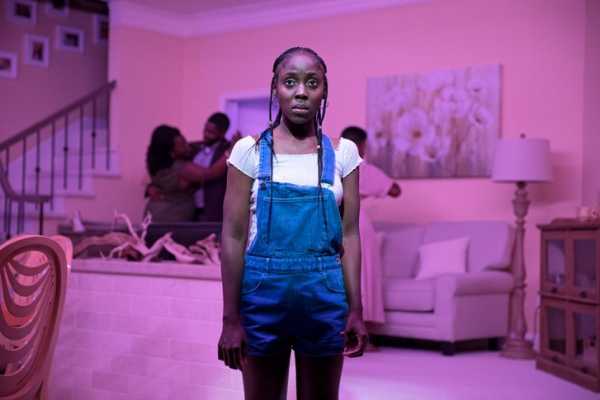
Photograph by Julieta Cervantes
Jackie Sibblies Drury’s gleefully twisted race play, at the SoHo Rep, turned the tables on its audience midway through, and then did it a few more times. Sarah Benson’s production began in the lighthearted sitcom style of “Family Matters,” as an African-American family gets ready for a birthday dinner. But then the action rewound and played again, with a panel of disembodied (white) voices observing the scene—and then intruding on it. Drury’s games of perception culminated with proscenium-busting coup de théâtre that left white audience members with a decision to make. The play’s summer run was concurrent with that of Young Jean Lee’s “Straight White Men,” on Broadway, and the two seemed like inverses and companion pieces, both asking who gets to watch whom.
4. “The Ferryman”
Jez Butterworth’s drama is both sprawling and expertly contained. Sure, it’s got a goose, a rabbit, a fire, a baby, and a twenty-one-person cast, but it moves like a heat-seeking missile toward its bloody climax. Sam Mendes’s production expertly recreates the warmth and the chaos of a crowded country home in County Armagh, in Northern Ireland. There, in 1981, the Carney family prepares for a harvest feast, as the violence of the Troubles lurks like an angry intruder. Butterworth’s play is a suspenseful tale of unsettled scores, of the tug-of-war between politics and family. But the texture of Mendes’s direction is what makes it feel so immediate. At the Bernard B. Jacobs Theatre through July 7th.
3. “The Waverly Gallery”
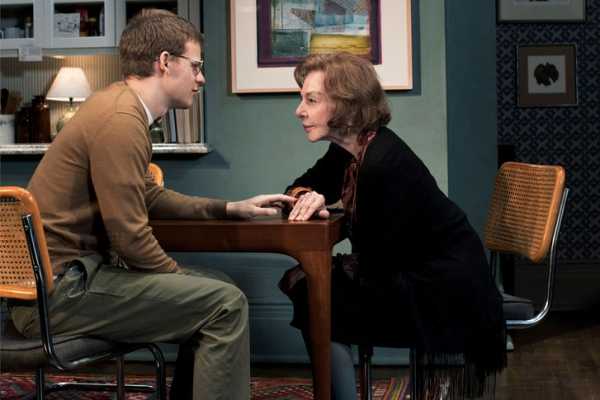
Photograph by Brigitte Lacombe
To see Elaine May’s return to Broadway—in the same theatre where she performed “An Evening with Mike Nichols and Elaine May,” fifty-eight years earlier—is to witness a slice of theatrical history. Her performance as Gladys, based on the playwright Kenneth Lonergan’s late grandmother, is a perfectly calibrated portrait of dementia, showing how personality can endure even after it’s unmoored from reality. It clearly takes enormous focus and precision to play a character who has neither, and May gives it everything she has. Her brilliance is reflected in the faces of the supporting cast, including Lucas Hedges, Joan Allen, and Michael Cera (who also appeared this year in a strong revival of Lonergan’s “Lobby Hero”). Lonergan’s memory play has an affecting simplicity: he wants us to bear witness, as he did, to a beloved woman’s decline. It’s at the Golden through January 27th.
2. “Oklahoma!”
Daniel Fish’s radical take on the Rodgers and Hammerstein classic unearths its eroticism and darkness; it’s like discovering a shot of absinthe in a blueberry pie. At St. Ann’s Warehouse, the audience entered a wooden-walled space resembling a small-town community center, complete with a wall of ominous rifles and a smattering of crock pots, from which chili was served at intermission. In Fish’s hands, the sunny anthem “Oh, What a Beautiful Mornin’ ” became a sinister bluegrass mating call; Jud Fry became a hipster incel with Kurt Cobain hair; and the dream ballet became a bewitching modern dance. These directorial incursions didn’t feel cheap. Like the Coen brothers’ “The Ballad of Buster Scruggs,” Fish teased out what was lingering all along in the lore of the American frontier—namely violence, patriarchy, and a ruthless coverup. If you missed it, don’t worry: the production is headed to Broadway in the spring.
1. “What the Constitution Means to Me”
In different ways, “What the Constitution Means to Me” and “Oklahoma!” both explore how America’s sunny origin myths aren’t so sunny after all. Part memoir, part town hall, the writer-performer Heidi Schreck’s show begins as a retread of her teen-age experience travelling Legion Halls and giving speeches on the U.S. Constitution for prize money. It evolves into an open-hearted yet shrewd look at the document’s tragic blind spots, and then into a hard-nosed but hopeful attempt to press onward. Like Hannah Gadsby’s “Nanette,” Schreck lures the audience with self-effacing charm—she’s like a middle-school history teacher who can’t wait to tell us interesting facts—and then pulls us deeper, to where the real damage lies. I saw the show, at New York Theatre Workshop, the week of Brett Kavanaugh’s confirmation to the Supreme Court, and it felt like both a balm and a road map. Fortunately, it has extended its run at Greenwich House, through December 30th. See it if you can.
Sourse: newyorker.com






